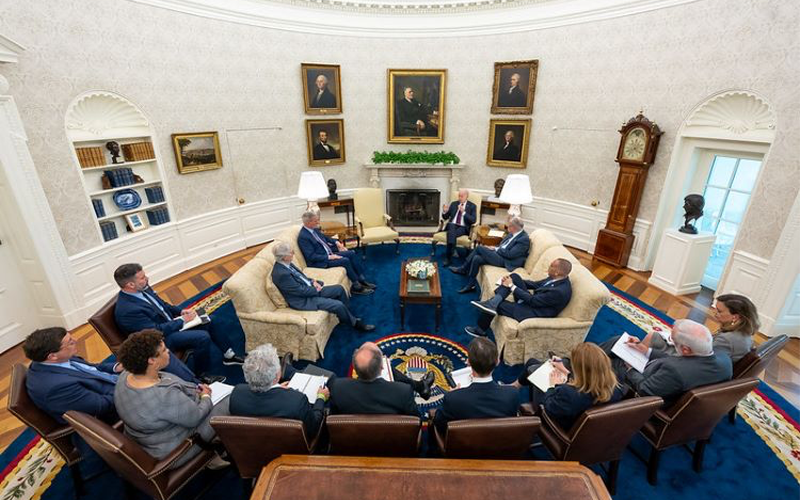GoWest Analysis of Debt Ceiling Legislation
Posted by Ryan Fitzgerald on June 3, 2023

On Saturday, June 3, President Biden signed the Fiscal Responsibility Act (H.R. 3746) into law. The measure will raise the debt ceiling, set federal spending for at least the next two fiscal years, as well as make additional policy determinations that are further outlined below.
The final structure of the agreement establishes a near two-year debt ceiling increase, pushing future debt ceiling debates past the 2024 Presidential Election, estimated to be reached on or around January 2, 2025. It includes a freeze on non-defense, discretionary spending levels in the upcoming 2024 fiscal year that starts in October, which would keep non-defense funding levels flat for FY2024 at $704 Billion, allowing a 1% increase in FY 2025 funding levels, which will likely lead to the budgetary fights shifting to individual appropriation bills.
Of particular interest to credit unions:
- The debt ceiling agreement will result in the federal government clawing back unspent and “unobligated” COVID relief funds to the Treasury, which were allocated as part of the CARES Act, the American Rescue Plan Act, and the 2021 Omnibus Appropriations Bill. The unobligated COVID relief funds being rescinded are outlined in 88 individual, programmatic line item areas, which are being clawed back into the federal treasury in order to offset other domestic spending.
- The main program directly impacting credit unions, which was included in the 88 programmatic recissions, is the permanent repeal of the Emergency Capital Investment Program (ECIP), within the CDFI system; however, the bill language specifically protects $284.5 Million in funds that have already been allocated for award. The initial ECIP awards totaled $8.34 Billion, and those dollars are not impacted. The GoWest team is working to gain specific clarity on what exactly is being protected in the $284 million outlined in the legislation. We are hopeful that the funds being protected are those funds that have been allocated for award during the second round of funding; however, we have heard from other groups that some of those funds may be protected to provide contract administration and support for the overall ECIP program. We continue to push for clarity on this question.
- Over $20 Billion of the overall $80 Billion in funds that were passed and signed into law in order to bolster the IRS will be rescinded, with $1.389 Billion being clawed back immediately, an additional $10 Billion in annual appropriations for FY 2024 and $10 Billion in FY2025 being pulled back to the Treasury to aid with offsetting other domestic program spending.
- The debt ceiling agreement would also require student loan borrowers to restart the repayment of their student loans beginning August 31st, which has remained on holiday since the pandemic freeze was established. The agreement does not specifically roll back President Biden’s plan to provide up to $20,000 in student loan debt for those who qualify; however, that issue remains in front of the U.S. Supreme Court to determine the constitutionality of the President’s plan to act without Congressional approval of that type of expense.
As we review the broader impacts of the debt ceiling agreement, it also includes the indirect impact of generally cutting government spending, which could reduce deposits overall and slow the pace of interest rate hikes. If you consider that the Federal Reserve is in a monetary tightening cycle then the impact of cuts to federal spending could help provide assistance to the Fed on this front. While the cut in government spending could relieve some of the pressure on the Fed related to interest rate hikes, it also could result in more immediate balance sheet pressure as these dollars would have found their way eventually into financial institutions. The balance sheet impacts are hard to measure but are likely to be a relatively small factor overall.
Additional highlights of the debt ceiling and budgetary legislation include:
- Additional four-year, non-enforceable funding budget target for Congress (2026-2029), which can be overridden by a new budget agreement(s) or with the passage of new appropriations legislation:
- FY 2026 – $1.662 Trillion
- FY 2027 – $1.638 Trillion
- FY 2028 – $1.655 Trillion
- FY 2029 – $1.671 Trillion
- Defense funding would be capped at President Biden’s original budget request, at $886 billion, about a 3.5 percent increase. Veterans’ medical care would also match the president’s request, at $121 billion in fiscal 2024.
- Tighter qualifications for the Supplemental Nutrition Assistance Program (SNAP), previously known as the Food Stamp program, which provides food assistance to needy families, as well as emergency cash aid known as Temporary Assistance for Needy Families (TANF). New work requirements would be phased in for healthy, single adults to receive benefits, by raising the current age of 49 to 55 in order for those individuals to receive assistance. These expanded time limits and age increases are outlined as a demonstration program, and would sunset and end if not renewed by Congress in 2030. This expanded work requirement would not apply to Medicaid recipients.
- The agreement includes adding “process efficiencies” to the decades-old law governing federal environmental reviews that is the pathway to new energy development projects being approved or denied. The bill included the controversial federal approval of a permit to construct the Mountain Valley Pipeline in West Virginia and Virginia, which is designed to bolster domestic natural gas production and delivery on the East Coast.
We are pleased to report that a bi-partisan group of Congressional leaders came together to ensure our country did not have an historic meltdown of our financial stability, which would have likely had an exceptional ripple effect on the overall global financial system. The GoWest team will continue to monitor the rollout of this legislation, while also working diligently to clarify certain programmatic line items outlined in the Fiscal Responsibility Act, specifically the ECIP grant program, as we realize a number of questions still remain for many of our member credit unions.
Posted in Advocacy on the Move, Federal Advocacy.





















